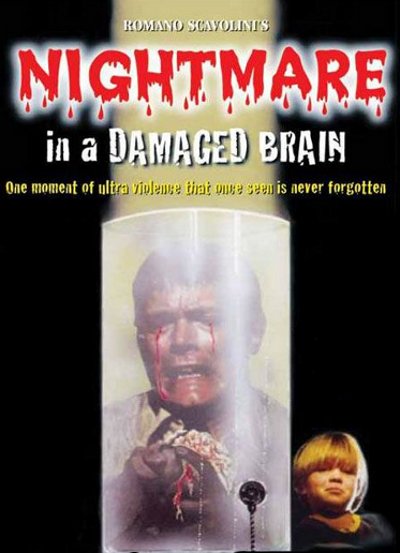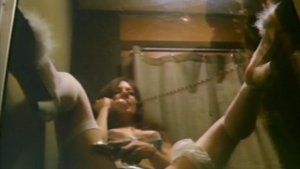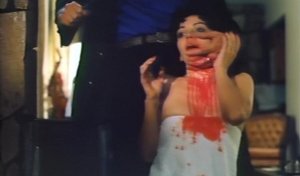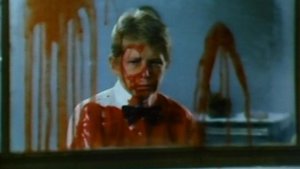
Romano Scavolini’s Nightmare was one of the most notorious of all the slasher films to emerge in the eighties. Distributed in the United Kingdom under the more infamous moniker Nightmare in a Damaged Brain, the film eventually fell foul of the Video Recordings Act 1984 and found its way onto the ‘video nasty’ list. Based loosely on the Project MK-Ultra scandal that first came to the attention of the American public in the mid-seventies, when it was revealed that the CIA had been conducting drug experiments on mental patients and convicts in order to try to re-introduce them to society. With scenes of a gruesome nature that would have been at home in an old Herschell Gordon Lewis flick, Scavolini’s tale of a mental patient unable to cope with his traumatic past would result in various law suits, including one in which British distributor David Hamilton Grant served six months of his eighteen month sentence for releasing a version one minute longer than the approved cut.
 George Tatum (Baird Stafford) is a patient at a New York mental institution who is plagued by constant nightmares of scenes of graphic violence involving a woman (Christina Keefe) being decapitated whilst performing various S&M games with her lover (William Kirksey). Constantly waking up screaming, his memories of his past have haunted him his entire life. Having spent years committed and subjected to countless psychological and emotional experiments, his doctor, Paul Williamson (Bill Milling) has come to the conclusion that he is now stable and ready to return to the world. He is eventually released and soon finds himself patrolling the red light district of the Big Apple, where he watches a sex show performed by a sleazy young woman (Tara Alexander, who once performed a sex marathon and ran the Show World in New York with her husband), who masturbates with a dildo whilst he watches, that is until his money runs out and a screen comes down between them.
George Tatum (Baird Stafford) is a patient at a New York mental institution who is plagued by constant nightmares of scenes of graphic violence involving a woman (Christina Keefe) being decapitated whilst performing various S&M games with her lover (William Kirksey). Constantly waking up screaming, his memories of his past have haunted him his entire life. Having spent years committed and subjected to countless psychological and emotional experiments, his doctor, Paul Williamson (Bill Milling) has come to the conclusion that he is now stable and ready to return to the world. He is eventually released and soon finds himself patrolling the red light district of the Big Apple, where he watches a sex show performed by a sleazy young woman (Tara Alexander, who once performed a sex marathon and ran the Show World in New York with her husband), who masturbates with a dildo whilst he watches, that is until his money runs out and a screen comes down between them.
The following day, George takes a boat away from the city whilst Dr. Williamson awaits for his patient to arrive. When he arrives back on land, George phones a house in Florida where young practical joker C.J. Temper (C.J. Cooke) answers. Unable to get a response from the caller, C.J. eventually hangs up and sets off to school, leaving his mother, Susan (Sharon Smith), in bed. Her boyfriend, Bob Rosen (Mik Cribben), spends much of his time at the harbour where he takes care of his boat. When his car breaks down in South Carolina, George sets his sights on a beautiful young woman (Kathleen Ferguson), whose backseat he hides in as she makes her way back home. Upon arrival, her boyfriend (William Paul), whom she had left back at the bar, calls her when suddenly the line goes dead. Suddenly, George appears behind and slits her throat before stabbing her in the stomach, all the while fantasizing about the night he butchered his parents.
 With George having disappeared all together, the doctors begin to panic that he could be up to his old ways, despite Dr. Williamson insisting that he is no longer dangerous. Back in Florida, C.J. is taking out the trash when he sees a creepy man standing across the road. It is George, who watches him whilst remembering himself as a young boy. Susan phones home just as C.J. staggers into the house, his stomach covered in blood. When his sister Tammy (Tammy Patterson) sees the mess she begins screaming, telling her mother that he is on the floor and covered in blood. Rushing home, C.J. claims that the man had stabbed him, only to discover that it was a tasteless joke. But with George increasingly obsessed with the family and his own bloodied past, it is only a matter of time before he attacks them for real.
With George having disappeared all together, the doctors begin to panic that he could be up to his old ways, despite Dr. Williamson insisting that he is no longer dangerous. Back in Florida, C.J. is taking out the trash when he sees a creepy man standing across the road. It is George, who watches him whilst remembering himself as a young boy. Susan phones home just as C.J. staggers into the house, his stomach covered in blood. When his sister Tammy (Tammy Patterson) sees the mess she begins screaming, telling her mother that he is on the floor and covered in blood. Rushing home, C.J. claims that the man had stabbed him, only to discover that it was a tasteless joke. But with George increasingly obsessed with the family and his own bloodied past, it is only a matter of time before he attacks them for real.
For those that found Ulli Lommel’s Boogeyman or William Lustig’s Maniac a little too tame, Scavolini’s Nightmare is a deeply unpleasant and gruesome study of insanity and exploitation. Originally conceived as Dark Games and produced for a mere $400,000 (an impressive sum due to the various locations between New York and Florida), the film was designed to be an extreme and confrontational piece, commenting on forced conformity in much the same way that Stanley Kubrick had done a decade earlier with A Clockwork Orange. Stafford’s performance as the increasingly disturbed antagonist constantly jumps between victim and violator, with George unable to deal with the experiments that the institution had conducted on him, ones which had clearly not cured him. It is an intense performance and he gives the character the depth required to make him convincing.
 Unfortunately, the same cannot be said for the rest of the cast. Milling does not make for a believable doctor, whilst Smith and Cribben add little to their respective characters. But by far the most annoying addition is Cooke, an obnoxious child who fails to generate any sympathy and proves to simply be annoying. The earlier scenes in New York are pure sleaze, with constant sex shows resembling a similar take on the city as had previously been seen in Taxi Driver. Despite a deeply illogical script, some truly amateur acting and a deeply cruel streak, there is something intriguing about Nightmare. Perhaps it is just how far the filmmakers are willing to go to disgust their audience, or the rather gruesome special effects (performed by Tom Savini if you believe the director) that guaranteed that the film would be banned in several countries under various names. By no means a masterpiece, but those wanting their slashers a little sleazier and more sadistic may enjoy this.
Unfortunately, the same cannot be said for the rest of the cast. Milling does not make for a believable doctor, whilst Smith and Cribben add little to their respective characters. But by far the most annoying addition is Cooke, an obnoxious child who fails to generate any sympathy and proves to simply be annoying. The earlier scenes in New York are pure sleaze, with constant sex shows resembling a similar take on the city as had previously been seen in Taxi Driver. Despite a deeply illogical script, some truly amateur acting and a deeply cruel streak, there is something intriguing about Nightmare. Perhaps it is just how far the filmmakers are willing to go to disgust their audience, or the rather gruesome special effects (performed by Tom Savini if you believe the director) that guaranteed that the film would be banned in several countries under various names. By no means a masterpiece, but those wanting their slashers a little sleazier and more sadistic may enjoy this.

10 Responses to Nightmare in a Damaged Brain (1981) Review